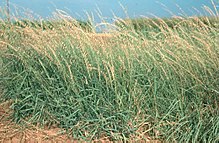Loading AI tools
Species of flowering plant From Wikipedia, the free encyclopedia
Bouteloua curtipendula, commonly known as sideoats grama,[3] is a perennial, short prairie grass that is native throughout the temperate and tropical Western Hemisphere, from Canada south to Argentina.
| Bouteloua curtipendula | |
|---|---|
 | |
| Scientific classification | |
| Kingdom: | Plantae |
| Clade: | Tracheophytes |
| Clade: | Angiosperms |
| Clade: | Monocots |
| Clade: | Commelinids |
| Order: | Poales |
| Family: | Poaceae |
| Genus: | Bouteloua |
| Species: | B. curtipendula |
| Binomial name | |
| Bouteloua curtipendula | |
| Synonyms[1][2] | |
|
Synonymy
| |
The species epithet comes from Latin curtus "shortened" and pendulus "hanging".

Sideoats grama is a warm-season grass. The culms (flowering stems) are 30–100 cm (12–39 in) tall,[4] and have alternate leaves that are concentrated at the bottom of the culm.[5] The leaves are light green to blue-green in color, and up to 6 mm (1⁄4 in) across.[5]

The flowers bloom in summer and autumn. They consist of compact spikes that hang alternately in a raceme along the top 15 to 25 cm (6 to 10 in) of the culm. The spikes often fall to one side of the stem, which gives the plant its name. There are 10–50 spikes per culm, and in each spike there are three to six spikelets, or rarely as many as 10. Each spikelet is 4.5 to 10 mm (3⁄16 to 13⁄32 in) long[4] and consists of two glumes and two florets. One of the florets is fertile, and has colorful orange to brownish red anthers and feathery white stigmas during the blooming period, which contrasts with the pale green, pale red, greenish-red, or purple[6] color of the spikes themselves.[5]
After blooming, the spikes become straw-colored. The fertile florets produce seeds, and when they are ripe, the spikes fall to the ground.[5]
Sideoats grama grows well on mountainous plateaus, rocky slopes, and sandy plains. It is drought- and cold-tolerant and is hardy in USDA hardiness zones 4–9 (average annual minimums of −30 to 25 °F, −34 to −4 °C).
It provides larval food for the veined ctenucha (Ctenucha venosa).[7]
It is currently listed as a threatened species in the U.S. state of Michigan. It is considered as an endangered species in Connecticut.[non-primary source needed]
Sideoats grama is considered a good foraging grass for livestock. It is planted for erosion control.
It is cultivated as an ornamental plant for native plant and drought-tolerant gardens.
Sideoats grama is the state grass of Texas.[8]
Seamless Wikipedia browsing. On steroids.
Every time you click a link to Wikipedia, Wiktionary or Wikiquote in your browser's search results, it will show the modern Wikiwand interface.
Wikiwand extension is a five stars, simple, with minimum permission required to keep your browsing private, safe and transparent.